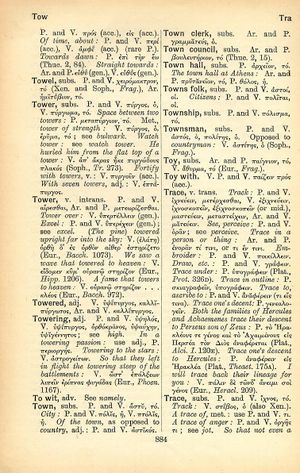trace
ὁ γὰρ ἀποθανὼν δεδικαίωται ἀπὸ τῆς ἁμαρτίας → anyone who has died has been set free from sin, the person who has died has been freed from sin, someone who has died has been freed from sin (Romans 6:7)
English > Greek (Woodhouse)
v. trans.
Track: P. and V. ἰχνεύειν, μετέρχεσθαι, V. ἐξιχνεύειν. ἰχνοσκοπεῖν, ἐξιχνοσκοπεῖν (or mid.), μαστεύειν, μεταστείχειν, Ar. and V. ματεύειν.
See, perceive: P. and V. ὁρᾶν; see perceive.
Trace in a person or thing: Ar. and P. ἐνορᾶν τί τινι, or τι ἔν τινι.
Embroider: P. and V. ποικίλλειν.
Draw, etc.: P. and V. γράφειν.
Trace under: P. ὑπογράφειν (Plat., Prot. 326D).
Trace in outline: P. σκιαγραφεῖν, ὑπογράφειν.
Trace to, ascribe to: P. and V. ἀναφέρειν (τι εἴς τινα).
Trace one's decent: P. γενεαλογεῖν.
Both the families of Hercules and Achaemenes trace their descent to Perseus son of Zeus: P. τὸ Ἡρακλέους τε γένος καὶ τὸ Ἀχαιμένους εἰς Περσέα τὸν Διὸς ἀναφέρεται (Plat., Alci. I. 120E).
Trace one's descent to Hercules: P. ἀναφέρειν εἰς Ἡρακλέα (Plat., Theaet. 175A).
I will trace back their lineage for you: V. πάλιν δὲ τῶνδʼ ἄνειμι σοὶ γένος (Eur., Heracl. 209).
subs.
P. and V. ἴχνος, τό.
Track: V. στίβος, ὁ (also Xen.).
A trace of, met.: use P. and V. τι.
A trace of anger: P. and V. ὀργῆς τι; see jot.
So that not even a trace of the walls is visible: V. ὥστʼ οὐδʼ ἴχνος γε τειχέων εἶναι σαφές (Eur., Hel. 108).

